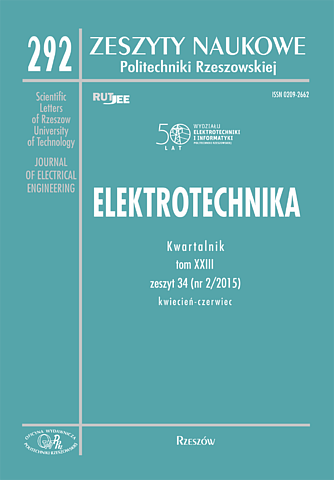Abstract
The paper presents results the analysis of the propagation of the electromagnetic field of lightning above ground. Calculation was done using a model of the cylindrical wave propagating around the discharge channel. The paper describes also the mathematical basis for modeling the phenomenon of lightning electromagnetic field propagation above the ground. The basic functions for determining the field components in the frequency domain for the perfectly conducting ground (reflecting field) was shown. The horizontal component of the electric field above the lossy ground was compared with Cooray-Rubinstein and Rubinstein approaches. A comparison of the results of the electric field intensity for selected parameters of lossy ground and at various distances from the discharge channel was presented. The results obtained for the case when the soil has been treated as a perfectly reflecting field was compared to those of the approaches. Calculations were performed for selected geometric and environmental parameters and for a few distances from the lightning channel. Results of the analysis are shown on the graphs as calculated time domain characteristics of signals used with the inverse Fourier Transformation IFFT. The study also related to problems when using a pair of transformations FFT-IFFT. Therefore, the calculations were performed using a modified form of the input lightning current pulse subjected to FFT transformation.
References
[2] Gamracki M.: Modelowanie matematyczne piorunowych zaburzeń elektromagnetycznych w liniach transmisyjnych, praca doktorska, Politechnika Rzeszowska, Wydział Elektrotechniki i Informatyki, 2004.
[3] C.A. Nucci at al: Lightning Return Stroke Current Models With Specified ChannelBase Current: A Review and Comparison, Journal of Geophysical Research, vol. 95, 1990, pp. 395-408.
[4] Rubinstein M.: An Approximate Formula for the Calculation of the Horizontal Electric Fields from Lightning at Close, Intermediate and Long Range, IEEE Transactions on Electromagnetic Compatibility, Vol. 38, No. 3, 1996, pp. 531-535.
[5] Rachidi F. et al.: Influence of a Lossy Ground on Lightning-Induced Voltages on Overhead Lines. IEEE Transactions on Electromagnetic Compatibility, Vol. 38, No. 3, 1996, pp. 250-264.
[6] Haddad M.A., Rakov V.A., Cummer S.A.: New measurements of lightning electric field in Florida: Waveform characteristics, interaction with the ionosphere, and peak current estimates, Journal of Geophysical Research, Vol. 117, 2012, pp. 1-26.
[7] Bajorek J., Gamracki M., Maslowski G.: Effectiveness of FFT-IFFT transformation during calculation of the electrical pulse under ground surface, Proc. 28th International Conference on Lightning Protection, Kanazawa, Japan, 2006, pp. 501-506. [8] Gamracki M.: Modelowanie matematyczne propagacji piorunowego zaburzenia elektromagnetycznego nad ziemią, Przegląd Elektrotechniczny, ISSN 0033-2097, NR 2/2012, s. 23-25.
[9] Gamracki M.: Modelowanie matematyczne propagacji piorunowego zaburzenia elektromagnetycznego nad stratną ziemią, Przegląd Elektrotechniczny, ISSN 0033- 2097, NR. 7/2014, s. 171-174.
[10] Bajorek J., Gamracki M., Maslowski G.: Modeling of lightning electromagnetic disturbances transmitted into the ground. Proc. XVI International Conference on Electromagnetic Disturbances, Kaunas, Lithuania, 2006, pp. 1132-1137.
[11] Masłowski G., Gamracki M.: Protection of Structures against LEMP, IEEE Bologna PowerTECH, June 23-26 2003, paper No. 520.
[12] Karnas G., Masłowski G.: Preliminary measurements and analysis of lightning electric field recorded at the observation station in the South-east part of Poland, Przegląd Elektrotechniczny, ISSN 0033-2097, NR 7/2014, s. 97-99.
[13] Karnas G., Wyderka S., Ziemba R., Filik K., Masłowski G.: Analysis of lightning current distribution in lightning protection system and connected installation, Przegląd Elektrotechniczny, ISSN 0033-2097, NR 1/2014, s. 122-126.





